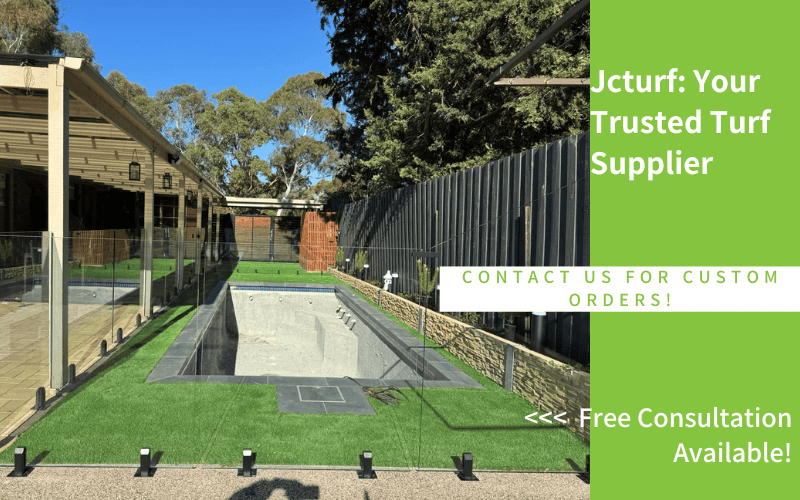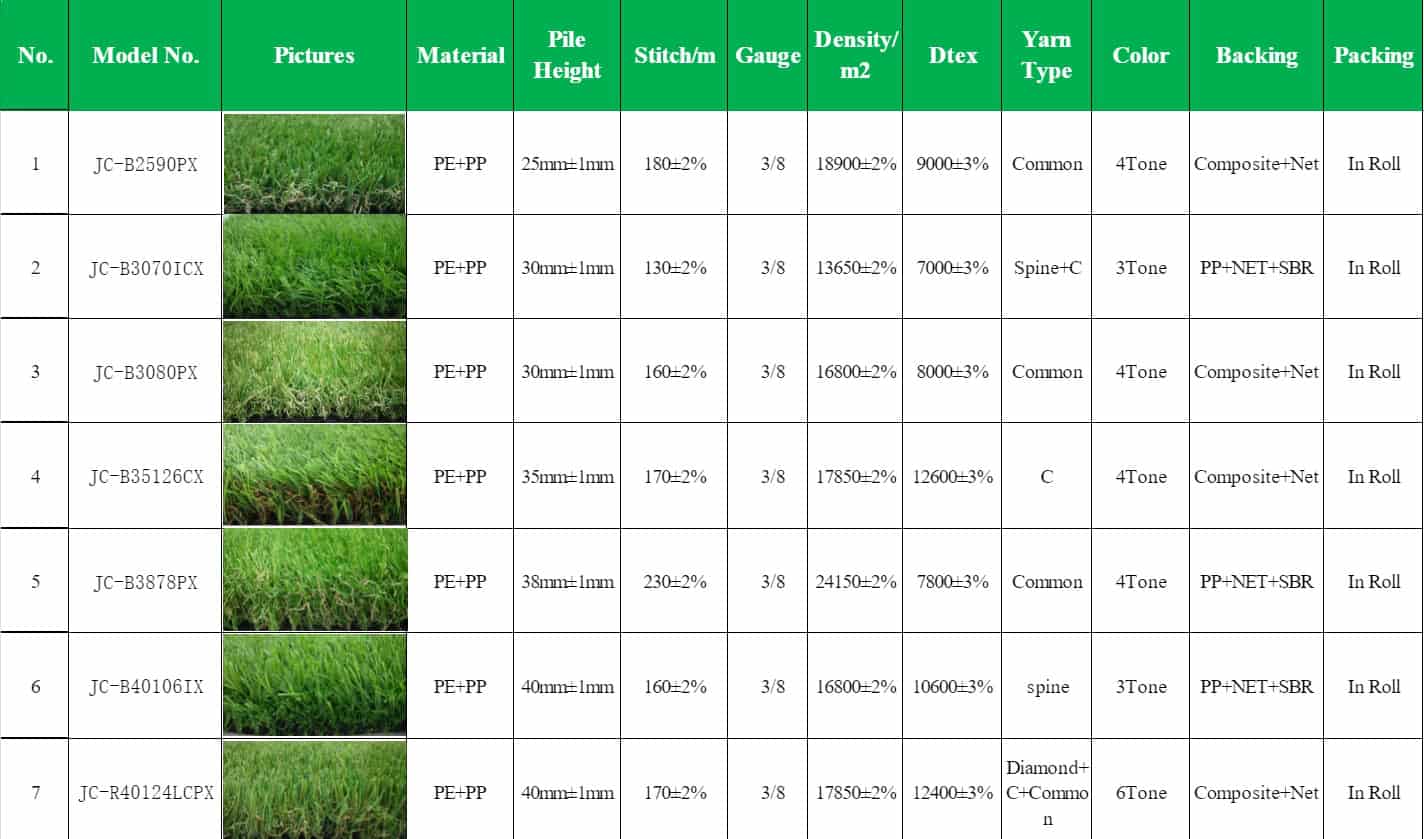Choosing artificial grass for your pool area isn’t as simple as picking the greenest roll. Many homeowners and designers get it wrong by focusing only on looks—ignoring how turf performs when wet, hot, or exposed to chemicals. The right turf can upgrade your poolside experience. The wrong one? It can create safety issues, discomfort, and costly headaches.
In this guide, you’ll learn exactly what makes artificial turf pool-friendly—from essential features like drainage, non-slip texture, UV protection, and barefoot comfort, to how well it resists chlorine and salt. We’ll also cover the pros and cons, answer safety questions, and give you a step-by-step install guide if you’re planning a DIY project. Not sure about upkeep or pricing? We’ll break down maintenance tips and total costs to help you plan smart.
How to Choose the Best Artificial Turf Around Pools & On Pool Decks
Not sure what kind of artificial turf works best near a pool? You’re not alone. Many people make the mistake of choosing turf based on looks alone—but for poolside areas, looks are just the start.
The best turf for around pools needs to handle water, heat, and constant barefoot traffic. In this section, we’ll walk you through five key features to look for when choosing the right artificial grass. Even if you’ve never bought turf before, you’ll know exactly what matters (and what to avoid) by the end.
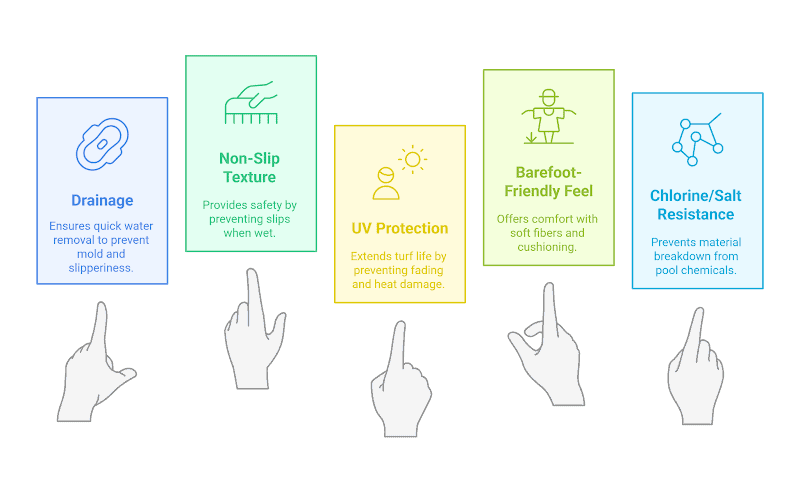
Drainage Is Non-Negotiable
Pool areas get wet—constantly. Choose turf with perforated backing so water can drain quickly. Without this, water will sit under the turf, leading to mold, odors, or a slippery surface.
Look for specs that say “drainage rate” or “permeable backing.” As a simple rule: if it doesn’t mention drainage, don’t buy it.
Avoid turf with a solid rubber or foam backing. These trap moisture.
Go for Non-Slip Texture
Safety is critical. The turf you choose should have a slightly grippy surface—not the super smooth type that gets slippery when wet. Some brands are made specifically for pool decks and label themselves as non-slip or high-traction.
If you’re buying in-store, rub your hand across the sample. If it feels too slick, it probably is.
UV Protection = Longer Life
Poolside turf lives under direct sunlight. Without UV resistance, the color fades and the fibers become brittle fast. Make sure the turf is UV-stabilized. This not only protects the appearance but also prevents heat damage over time.
UV-resistant turf usually comes with longer warranties—check for 8–10 year coverage.
Soft, Barefoot-Friendly Feel
Pools mean bare feet. Avoid turf with stiff, wiry blades—it may look real but feels rough. Instead, go for turf made with polyethylene fibers, which are soft, cool, and safer for kids.
Also check that it has a dense thatch layer underneath. This adds cushioning without making it feel squishy.
Avoid budget turf that looks plasticky or feels sharp when pressed. It won’t feel good underfoot.
Resists Chlorine and Salt
Some turf can break down faster when exposed to pool water. Always choose a product labeled chlorine-resistant or saltwater-safe, especially if you have a saltwater system.
Rinsing the turf after heavy use helps, but the material itself should be built to last around chemicals.
Summary: What to Look for in Poolside Turf
- Drainage: Perforated backing, no solid rubber
- Non-slip surface: Grippy, high-traction texture
- UV protection: Prevents fading and overheating
- Soft feel: Polyethylene fibers + thatch cushioning
- Chemical resistance: Built for chlorine or salt exposure
Pros and Cons of Using Artificial Turf Around Pools
Wondering if artificial turf is a smart choice around your swimming pool? You’re not alone. While this option is becoming more popular, it’s important to understand both the upsides and the trade-offs.
In this section, we’ll break down the main benefits and drawbacks of installing artificial grass near a pool. Whether you’re comparing turf to natural grass, pavers, or concrete, this guide will help you decide if turf fits your needs.
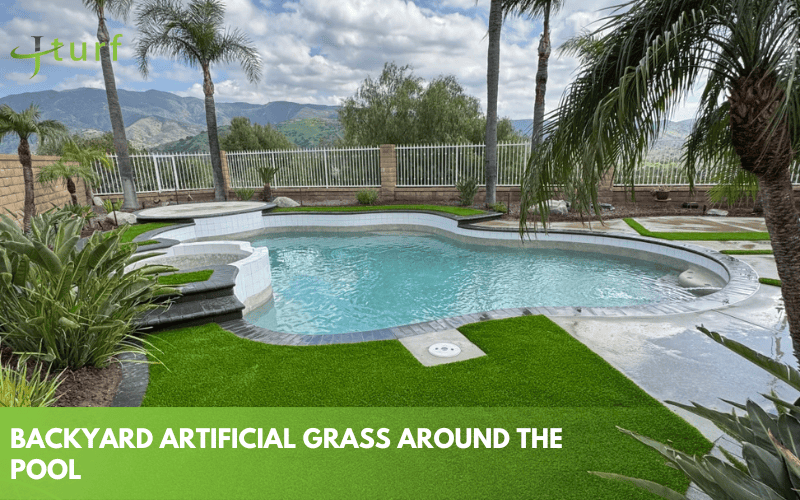
Pros of Artificial Turf Around Pools
Artificial turf offers several advantages for poolside areas, especially when installed correctly.
- Clean and Mud-Free Surface
Unlike natural grass, turf doesn’t turn into a muddy mess when wet. There’s no loose soil or dead grass getting into the water, which helps keep your pool cleaner. - Always Looks Green
Turf stays lush and vibrant year-round, even in harsh sunlight. No brown patches. No burnt spots from chlorine or sun exposure. - Low Maintenance
No mowing, no watering, no fertilizing. All you need is occasional rinsing and brushing—especially helpful in hot summer months when grass typically struggles. - Comfortable for Bare Feet
Quality turf designed for pool areas stays cool enough underfoot and provides a soft surface that’s easier to walk on than concrete or rough pavers. - Better Safety Than Hard Surfaces
Artificial turf can offer more grip than wet tiles or wood. It also provides a softer landing if someone slips, which is important around water.
Cons of Artificial Turf Around Pools
Artificial turf isn’t perfect, and it’s important to know its limitations before making a decision.
- It Can Get Hot in Direct Sunlight
Even good turf can heat up under full sun. Some infills or light-colored blades can reduce this effect, but it’s still warmer than natural grass. You may need to use water misting or shading for comfort. - Upfront Cost Is Higher
Compared to basic grass seed or pavers, turf installation can be more expensive. While you’ll save on maintenance long-term, the initial price may surprise some homeowners. - Poor Drainage Can Be a Problem
If the turf doesn’t have proper backing or if the base isn’t well-prepared, water may collect and cause odors or slippery conditions. Drainage is critical. - Not All Turf Is Pool-Ready
Some cheaper products aren’t designed to handle chlorine, saltwater, or heavy foot traffic. Choosing the wrong turf can lead to fading, cracking, or quick wear. - May Require Occasional Cleaning
Debris like leaves, sunscreen, or pool chemicals can build up and require light cleaning. It’s not zero-maintenance, just low-maintenance.
Is Artificial Turf Safe to Use Around Pools?
Safety is one of the biggest concerns when installing artificial turf around pools. Whether you’re worried about slipping, chemical damage, or comfort for kids, it’s important to know what you’re getting into.
In this section, we’ll answer four common safety questions: Is turf slippery when wet? Is it safe for bare feet and children? Can it resist pool chemicals like chlorine? And is the turf material itself non-toxic? By the end, you’ll know exactly how safe turf really is—and what to look out for.
Is Turf Slippery When Wet?
Turf can be slippery—but only if you choose the wrong kind. Well-designed turf for poolside use has textured, non-slip backing and blade surfaces that provide grip, even when wet.
Cheaper turf with glossy or flat fibers tends to become slick underfoot. Always check the product description for phrases like “non-slip,” “pool-grade,” or “high-traction.” If you’re unsure, test a small piece with water and bare feet.
Tip: Textured polyethylene turf with drainage backing usually performs best for wet areas.
Is It Safe for Kids and Bare Feet?
Yes—if the turf is soft, well-padded, and not overheated. Choose turf with polyethylene blades, which are softer than nylon and less abrasive. Look for a built-in thatch layer for cushioning. This creates a gentle surface that’s safe for kids to walk, sit, or even fall on.
However, some turf can get hot in the sun. If your pool area is fully exposed, consider:
- Using turf with heat-reducing infill
- Adding shade or misting systems
- Choosing lighter-colored turf
Pro tip: Always test turf temperature by standing barefoot on it during peak sun hours before final installation.
Can Turf Handle Chlorine and Pool Chemicals?
Yes, but only if it’s made for poolside conditions. Regular artificial turf may break down over time when exposed to chlorine, saltwater, or sunscreen residues. Pool-safe turf is specifically treated to resist chemical damage.
Before you buy, check for:
- “Chlorine-resistant” or “chemical-safe” in the product specs
- UV-stabilized coating for extra protection
Also, rinse turf weekly if it gets heavy splash exposure. This keeps it clean and extends its lifespan.
Is Artificial Grass Made from Safe Materials?
Yes, most modern turf is made from non-toxic polymers like polyethylene or polypropylene, and many are lead-free and heavy-metal free. That said, not all products meet the same standards.
If you’re buying for a family home, check if the turf:
- Is labeled “lead-free” or “child-safe”
- Complies with US or EU safety certifications
- Comes from a reputable supplier (avoid unknown brands with no material disclosure)
Always ask for safety data if it’s not listed. Trusted suppliers are happy to provide it.
How to Install Artificial Grass Around a Pool Deck (Step-by-Step)
Installing artificial grass around a pool isn’t hard—but it does take planning and care. If you’re thinking of doing it yourself, you’ll want to understand each step before you begin. Doing it right means your turf will drain well, feel good underfoot, and last for years.
Below are 8 basic steps to help you install artificial turf around a pool, even if it’s your first time. These tips work whether you’re placing turf on soil, compacted ground, or beside concrete.
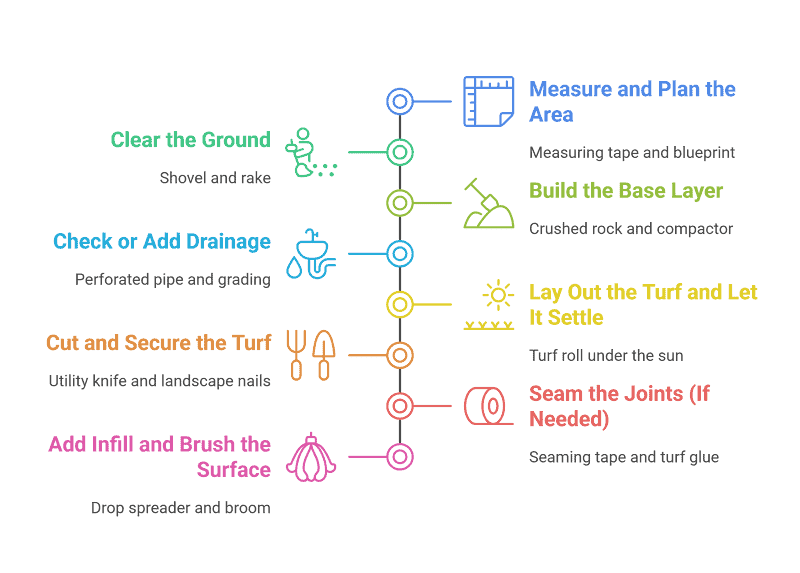
Step 1: Measure and Plan the Area
Before anything else, measure the shape of your pool and the surrounding area. Mark out curves, corners, or any objects like ladders or drains. Sketch a rough layout. This will help you order the right amount of turf and plan cuts in advance.
Tip: Add 5–10% extra turf to cover mistakes or odd angles.
Step 2: Clear the Ground
Remove all grass, weeds, stones, or old material. Dig about 3–4 inches deep to allow for a base layer. If roots remain, they may grow through the turf or damage drainage later.
Use a shovel, rake, and weed barrier fabric. Level the ground as evenly as possible.
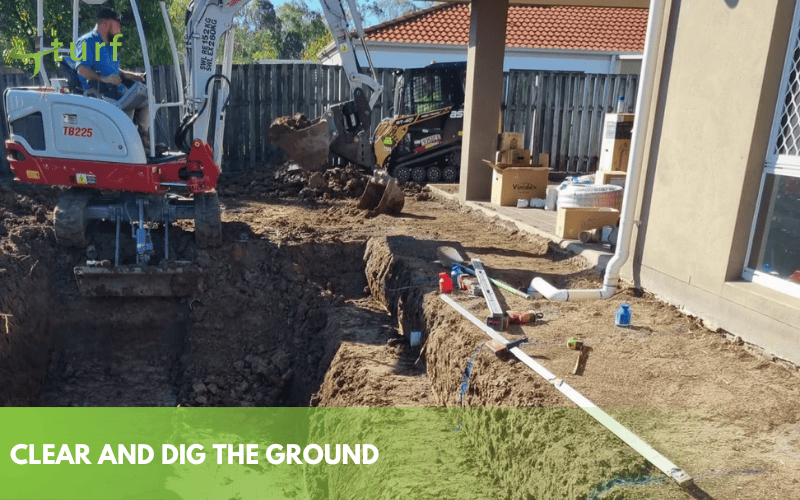
Step 3: Build the Base Layer
Add a layer of crushed rock or decomposed granite. This should be about 3 inches thick. Spread it evenly and compact it using a plate compactor (available at tool rental shops). A solid base gives your turf structure and helps water drain.
Avoid using sand alone—it shifts too easily underfoot.
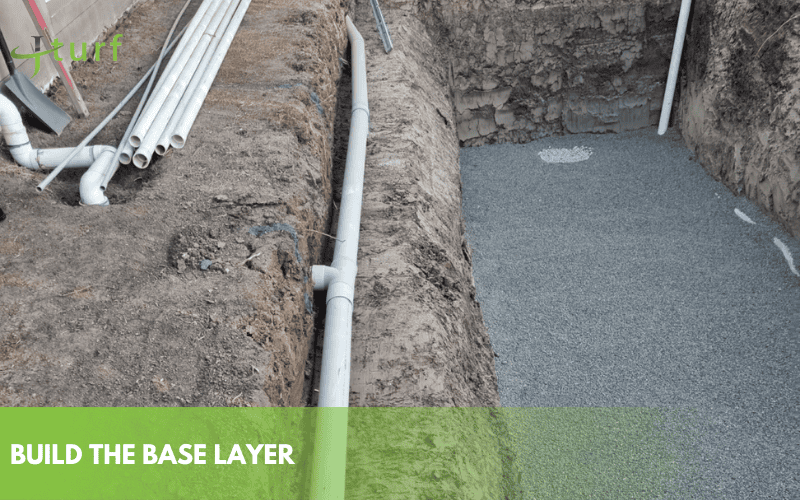
Step 4: Check or Add Drainage
Pool areas get wet, so drainage is key. If the ground is flat or enclosed, you may need to install a perforated pipe (French drain) or grade the area slightly away from the pool.
You can also choose turf with high drainage rates to improve water flow.
Step 5: Lay Out the Turf and Let It Settle
Roll out the turf and let it sit under the sun for at least 1–2 hours. This helps relax the fibers and prevents wrinkles. Align the blades in one direction for a natural look.
If you need multiple rolls, make sure the grain of each piece matches.
Step 6: Cut and Secure the Turf
Use a sharp utility knife to trim the turf to fit the area. Be careful around curves and edges. Then, secure the turf with landscape nails or turf staples every 4–6 inches along the border.
Avoid stretching the turf—it can cause ripples later.
Step 7: Seam the Joints (If Needed)
If using more than one roll, you’ll need to join the seams. Lay seaming tape under the edge of both rolls, apply turf glue, and press firmly. Let it cure as recommended by the glue brand.
Don’t overlap edges. A small gap is better than a raised seam.
Step 8: Add Infill and Brush the Surface
Spread silica sand or cooling infill evenly across the turf using a drop spreader. Then brush the surface with a stiff broom or power broom to help the blades stand up.
This keeps the turf looking natural and helps it stay cool underfoot.
Maintenance Tips for Turf Around Pools
Artificial turf around a pool is low-maintenance—but that doesn’t mean no maintenance. A few simple habits can help your turf last longer, stay clean, and feel great underfoot.
- Rinse the turf weekly. Use a garden hose to wash off chlorine, salt, sunscreen, and dust. This prevents buildup that can make the surface sticky or dull over time.
- Remove leaves and debris often. Clear away leaves, twigs, and organic matter using a plastic rake or leaf blower. Debris can trap moisture and lead to mold if left too long.
- Brush the turf once a month. Use a stiff broom or a power brush to lift the fibers and keep them standing tall. This also helps redistribute the infill (small granules that support the blades).
- Clean up pet waste promptly. Scoop solids and rinse the area with mild soap and water. Most turf won’t absorb odors, but quick cleaning keeps it fresh.
- Inspect edges and seams every few months. Look for loose nails, lifted corners, or split seams. Fixing small issues early prevents bigger repairs later.
You don’t need any special tools or products—just basic care. Turf maintenance takes minutes, not hours, and makes your poolside space safer and better looking year-round.
How Much Does It Cost to Install Artificial Turf Around a Pool?
Worried about the cost of artificial grass around a pool? You’re not alone. Whether you plan to DIY or hire a professional, it helps to know what makes up the total price.
In this section, we’ll break down the three main cost factors: the turf and materials, installation labor, and long-term upkeep. Knowing what to expect can help you budget smarter—and avoid surprises.
Turf and Materials
Most pool-friendly artificial turf ranges from $5 to $10 per square foot, depending on quality, pile height, and drainage features. Products labeled as UV-resistant or chlorine-safe usually cost more, but last longer in outdoor, wet environments.
Beyond the turf itself, you’ll need:
- Infill: $0.50–$1.00 per sq ft for silica sand or cooling infill
- Base materials: gravel, decomposed granite, or similar—roughly $1–$2 per sq ft
- Other supplies: nails, seam tape, weed barrier—often $0.50–$1.00 per sq ft
Total material cost typically falls between $7 to $13 per sq ft, excluding labor.
Installation Labor
Hiring a professional crew can add $4 to $8 per sq ft in labor costs. The price depends on access to the site, the complexity of the layout, and whether extra grading or drainage is needed.
If you go the DIY route, you can save most of the labor cost—but you may still spend on:
- Tool rentals (e.g., plate compactor): $50–$100 per day
- Delivery fees for heavy base materials
- Extra turf (usually 5–10% more than your measured area)
Example cost estimate:
For a poolside area of about 300 square feet (a common patio size), here’s what you might pay:
- DIY installation: $2,100–$3,900 total
- Professional installation: $3,300–$6,300 total
This range includes turf, base materials, infill, and installation supplies. Labor costs are included in the professional estimate but excluded from the DIY range. Actual prices may vary based on your region, layout, or turf type—but this gives you a helpful starting point.
Ongoing Maintenance Costs
Artificial turf is much cheaper to maintain than natural grass, but not totally free.
Expect to spend small amounts on:
- Occasional rinsing (adds to your water bill slightly)
- Brushing tools or maintenance broom (one-time purchase ~$30–$80)
- Minor repairs or seam fixing, if needed after several years
You don’t need fertilizers, pesticides, or lawn mowing, which saves hundreds per year over time.
Wrapping It Up: Choosing Turf Around Your Pool, Made Simple
Choosing the right artificial turf for your pool area doesn’t have to be complicated. You’ve now seen what really matters—like drainage, slip resistance, and heat safety—and what to avoid, from cheap materials to poor installation.
We’ve walked through the pros and cons, looked at safety questions, showed you how to install turf step by step, and even gave you tips for easy maintenance. You also got a realistic sense of what it all might cost, whether you’re hiring help or going the DIY route.
If you were feeling unsure at the start, hopefully this guide helped you feel more confident and better prepared to make the right decision for your poolside space.
Ready to Build Your Ideal Poolside Turf?
Not all turf works well around water—but ours does. At Biyuan, we make artificial grass specifically for pool areas, with:
- Non-slip grip, thanks to blade texture and anti-skid backing
- UV- and chlorine resistance, using pool-grade, tested yarn
- Soft-touch feel, made from barefoot-friendly PE fibers
- Fast drainage, via perforated SBR backing
- 6–8 year warranty, backed by certified quality standards
As a direct turf manufacturer, we control production and offer factory pricing without middlemen. Whether for a family pool or a resort deck, we’ve got you covered.
Need a recommendation? Our team can help you choose the best turf for your layout, climate, and use—no matter your project size.

